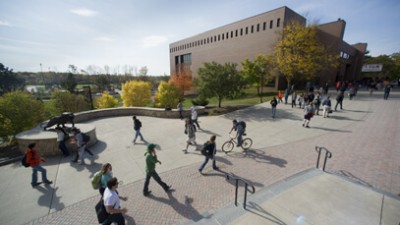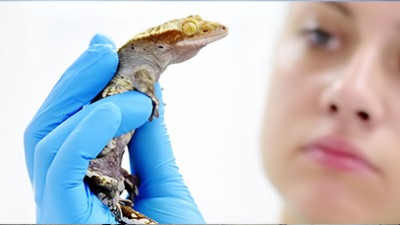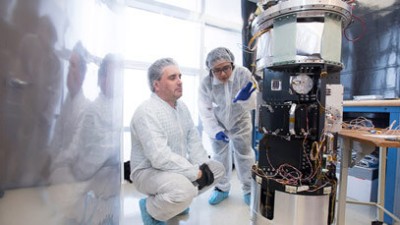John Wiley Jones Outstanding Students in Science

John Wiley Jones
Outstanding Students in Science
Each year, one student from each of the College of Science’s five academic units is honored with the John Wiley Jones Outstanding Student in Science award for academic excellence, citizenship, and campus contributions.
2024-2025 John Wiley Jones Award Recipients

Emma Thompson
Thomas H. Gosnell School of Life Sciences
Emma Thompson, a 4th year Biology student from Cresco, Pennsylvania, has played an integral role in several microbial ecology research projects with her mentor, Dr. Elle Barnes. Emma was awarded an Emerson Summer Research grant focusing on how temperature might shift the ability of salamander skin bacteria to inhibit fungal pathogens and went on to present her research at both the 2024 RIT Summer Undergraduate Research Symposium and the 2024 Finger Lakes Microbiome Symposium. She was recently awarded a grant from Rochester Academy of Science to support continuation of her work, where the academy praised her well-written and well-organized proposal. In addition to research, Emma loves to read and is passionate about inclusion, science education and communication. She is involved in her lab’s current activities in partnership with NYS Department of Environmental Conservation, Rochester City’s Earth Explorers program, and Rochester Ecology Partners. In describing her accomplishments, thus far, Emma’s mentor notes, “These are just some of many examples of the diligence and independence she shows towards her research—a vital characteristic to success in science and one that I believe will be a strength for her as she continues to pursue a PhD.”

Veran Stanek
School of Physics and Astronomy
Veran Stanek is a third-year student in the School of Physics and Astronomy pursuing a combined BS/MS degree in physics (BS) and materials science and engineering (MS), as well as a minor in mathematics. They are a member of the RIT Honors program and enjoy working as an Honors Mentor. Veran has worked to gain as much hands-on research experience in as many places as possible during their time at RIT. After their first year, they participated in an REU (Research Experience for Undergraduates) at the College of Wooster, working on a project simulating a black hole event horizon using a Belousov-Zhabotinsky chemical reaction diffusion system advised by Dr. Niklas Manz. This experience spurred on their enjoyment of blending chemistry and physics together, driving them to enroll in their current MS program. Outside of academics, Veran is heavily involved in Historical European Martial Arts (HEMA), both on and off campus. At RIT, they have worked as the RIT HEMA Club’s armorer, treasurer, and event coordinator, and have helped to establish RIT as a club that can host tournaments and events for the wider HEMA community.

Mya Soto
School of Chemistry and Materials Science
Mya Soto, from Seneca Falls, NY, is a fourth-year student in the School of Chemistry and Materials Science (SCMS) at RIT, pursuing a B.S. in Biochemistry with an Immersion in Global Public Health. Her research has been supported by a Rochester Academy of Science grant, a prestigious SCMS Pasto Co-op Fellowship, and the McNair Scholars Program. Mya’s dedication to research, leadership, and community involvement has earned her numerous national accolades. She has been inducted into the ASBMB National Honor Society, received the ASBMB Marion B. Sewer Distinguished Scholarship, and was named an American Chemical Society (ACS) Scholar. Most notably, Mya received the prestigious ACS Priscilla Carney Jones Scholarship Award, which is granted annually to only one female undergraduate chemistry student in the entire United States. After earning her degree, Mya plans to pursue a Ph.D. in a Biochemistry-related field to explore molecular mechanisms underlying infectious diseases.

Dorothy Suzuki-Burke
School of Mathematics and Statistics
Dorothy Suzuki-Burke is an RIT Honors student and applied mathematics major from Highland, New York. She will graduate this May with a B.S. in Applied Mathematics and a general education immersion in Japanese. By the time she arrived at RIT, she was already quite focused and dedicated to her studies. Dorothy was so passionate about mathematics that, during her first year on campus, she independently studied linear algebra and thoroughly enjoyed exploring proofs while taking an introductory course. Dorothy is also active in a variety of on-campus clubs and activities. Dorothy is an RIT Performing Arts Scholar. She is involved with the Association for Women in Mathematics, the Game Symphony Orchestra, the Society of Asian Scientists and Engineers, and she’s held multiple leadership roles in PiRIT, the student math organization. Dorothy is planning to pursue a doctorate in applied mathematics and is currently in the “decision phase” of determining where she will continue her studies.

Mason Wahlers
Chester F. Carlson Center for Imaging Science
Mason Wahlers is a fourth-year student in the Chester F. Carlson Center for Imaging Science, pursuing a Bachelor of Science in Imaging Science with a strong focus on computer vision and optical engineering. Throughout his time at RIT, Mason has demonstrated a deep passion for imaging technology, leading multiple research projects and internships in the field. Beyond the classroom, Mason has gained valuable industry experience through internships at Corning and Boeing. Mason has also been an active member of the RIT community. Outside of academics, Mason enjoys exploring music and electronics. He designs and builds custom guitar effect pedals, applying his technical knowledge in signal processing. His passion for both engineering and creative problem-solving makes him a well-rounded and dedicated engineer.
Past Award Recipients

Liam Almekinder
School of Chemistry and Materials Science

Nick Duggan
Chester F. Carlson Center for Imaging Science

Gabriel Johnson
School of Mathematics and Statistics

Shui Li Eu-Balint
Thomas H. Gosnell School of Life Sciences

Myrra Small
School of Physics and Astronomy

Emily Finson
School of Physics and Astronomy
Anna Mason
Chester F. Carlson Center for Imaging Science

Gabriella Orfanides
Thomas H. Gosnell School of Life Sciences

Hannah Sheets
School of Mathematics and Statistics

Elaina Stafford
School of Chemistry and Materials Science

Ian Freezman
Thomas H. Gosnell School of Life Sciences

Zoë LaLena
Chester F. Carlson Center for Imaging Science

Matt Law
School of Chemistry and Materials Science

Ashley Martsen
School of Physics and Astronomy

Cade Reinberger
School of Mathematics and Statistics

Nana Aikins
School of Chemistry and Materials Science

Lucas Berens
School of Physics and Astronomy

Jonathan Chu
Thomas H. Gosnell School of Life Sciences

Lily Gaffney
Chester F. Carlson Center for Imaging Science

Adam Giammarese
School of Mathematics and Statistics

Grace Fiacco
School of Physics and Astronomy

Quinn Kolt
School of Mathematics and Statistics

Emily Mahoney
School of Chemistry and Materials Science

Greg Nero
The Chester F. Carlson for Imaging Science

KayLee Steiner
Thomas H. Gosnell School of Life Sciences
About John Wiley Jones
 John Wiley Jones had a passion for science education and was a generous contributor to academic excellence at RIT. In 1974, Jones Chemicals established the John Wiley Jones Distinguished Lectureship in Science to contribute to the education programs of RIT’s College of Science. Jones intended to bring eminent scientists to the RIT campus with the expectation of a formal lecture presentation open to the public. The company also created an endowment to support science education at RIT, the first grant of its kind in the university's history.
John Wiley Jones had a passion for science education and was a generous contributor to academic excellence at RIT. In 1974, Jones Chemicals established the John Wiley Jones Distinguished Lectureship in Science to contribute to the education programs of RIT’s College of Science. Jones intended to bring eminent scientists to the RIT campus with the expectation of a formal lecture presentation open to the public. The company also created an endowment to support science education at RIT, the first grant of its kind in the university's history.
A portion of this endowment was used to establish the John Wiley Jones Award for Outstanding Students in Science as a tangible expression of Mr. Jones’s wish to help and encourage young people to prepare themselves for careers in scientific fields. He believed that protecting the environment and making the world safer and more fruitful for all people posed a significant challenge for future scientists. In their selection of the John Wiley Jones Outstanding Students in Science, the five academic units of the College of Science must consider the student’s academic achievements, citizenship, and contributions to the quality of campus life.




